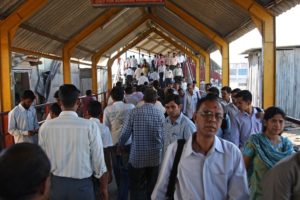
IDJ ENGLISH
『International Development Journal』2019 October edition
High Quality Infrastructure Special
Current status of the Indian High-Speed Railway Project
In December 2015, a memorandum of understanding was signed between the Japanese and Indian governments regarding a high-speed railway, and it was clearly stated that the Japanese Shinkansen system would be adopted for high-speed rail in India. The Japanese method will be adopted for the approximately 505 km route between Mumbai and Ahmedabad, which is positioned as the first priority development route among the seven candidate routes in India. The total project cost is approximately 1.8 trillion yen. About 80% of the total will be covered by yen loans from bilateral ties. As it was an unprecedentedly large-scale project, there were various concerns at the beginning of the project as to whether the opening in 2023 and land acquisition would be successful.
According to Japan International Cooperation Agency (JICA), on the progress, it is said that public works tender for civil works such as elevated and undersea tunnels and vehicles are being announced one after another. Elevated construction is publicly announced for Indian companies, and highly difficult undersea tunnels are publicly announced for Japanese companies. As for land expropriation, about 30% of the total has already been completed due to the active efforts of the Indian government. JICA says that it is moving at a very good speed compared to other public works in India.
In relation to human resource development, construction of training facilities in Vadodara and Sabalmati in Western Gujarat has already started. I have heard that the completion of both facilities will be more than a year away. To that end, there will be training to develop human resources who will play a central role in the operation of high-speed railway.
In addition, although it was not initially planned, Japan also supports the development in front of the station. Looking at these moves, the business seems to be progressing accordingly. However, it is also true that it is not straightforward.
As public announcements are made one after another, one of the challenges will be the participation of Japanese companies. Up to now, the tender failure has been seen as a problem in the Japanese technology utilization conditions “Special Terms for Economic Partnarship (STEP)” application cases, and such a concern cannot be wiped out even with the Indian high-speed railway. In fact, I hear that many companies are carefully considering the difficulty of doing business in India and the profitability of high-speed rail.
However, Yamamoto said, “Only other high-speed rail projects such as Indonesia and Brazil are in the midst of India, and only India has reached the bidding stage. India also has other planned routes. The market scale is extremely large in the long run, not just looking at profitability on the route. ” Companies such as France, China, and Germany seem to be actively selling with emphasis on such potential. That said, it’s still in the bidding phase, and it’s likely that we will need to see a little more into the future.
Ministry of Foreign Affairs aims to expand budget
As seen in the Indian high-speed railway, Japan’s export of “quality infrastructure” has focused on the quantitative expansion of yen loans and the promotion of all Japan. However, the export of infrastructure in such a narrow sense of “national interest bias” is changing. Long-term business participation, including third-country collaboration and “Operation and Maintenance (O & M)”, will be promoted, and soft infrastructure like human resource development will be emphasized more than ever.
Under such circumstances, the Ministry of Foreign Affairs also intends to strategically utilize ODA to support the continuous involvement of private companies, such as O & M, in exporting high-quality infrastructure. Specifically, when private companies use ODA loans and JICA’s Private Sector Investment Finance, JICA aims not only to provide O & M services, including facility maintenance and parts and materials supply, but also to localize O & M that is attractive to developing countries. JICA plans to package new support measures for human resource development and capacity building.
It is not without precedent. One of them is support for the construction of Sihanoukville Port in Cambodia. The project has been implemented since 1999 through ODA loans, grant aid, and technical cooperation, and has also been involved in management such as investing in Sihanoukville Port Corporation as JICA’s Private Sector Investment Finance, and dispatching a non-executive director recommended by JICA. It covers assistance for capacity building related to logistics in general.
From the perspective of promoting “quality infrastructure investment” to strengthen regional connectivity, the Ministry of Foreign Affairs believes that it is important to expand the ODA budget including the JICA general account budget. In fact, of the estimated demand for the budget for FY2020 compiled by the Ministry of Foreign Affairs in August of ¥ 793.7 billion (an increase of ¥ 63.0 billion from the original budget for FY2019), ODA was ¥ 55.1 billion, an increase of ¥ 67.5 billion.
In the future, MOFA expects JICA to improve the budget execution management system and make efforts to prevent the recurrence of problems related to budget management. It has been highly evaluated as a Japanese ODA implementing body that promotes global development, and it will continue to play such a role in the future. He also mentioned that JICA would play a role in nurturing Japanese human resources who are active in the international community. He also pointed out that JICA will continue to work closely with the Ministry of Foreign Affairs to form projects in line with foreign policy.
In order to continuously carry out Japan’s responsible development cooperation, particularly in the field of consulting, the issue is to strengthen the international competitiveness of Japanese companies. The MOFA has a policy of actively providing support with the cooperation of relevant ministries and agencies for the fundamental resolution of issues. MOFA said to the development consultants, “I want consultants to continue to actively work on the challenges of further improving the quality of various operations and increasing price competitiveness through the use of digital technology and diverse human resources. ”.
Financial instability with infrastructure alone
How will JICA move under these policies? As for O&M promotion, the company will promote the utilization of O & M loans, which have not been proven so far.
O&M loans are infrastructure facilities such as power generation facilities established by local governments and other donors, with Japanese companies providing spare parts, human resource development, maintenance, and in some cases contracts with the executing agency using the funds of the loan. It will be responsible for management. Mr. Tetsutaro Kon, the JICA Planning Department, said, “As a Japanese aid philosophy, so far, even if we support the ability to make things and maintain them, the actual maintenance will be carried out by developing countries using their own funds. “O & M loans have not been implemented so much,” he said. However, from now on, it will be possible to actively promote O & M loans. “Rather than just supporting the financial side, we will also provide human resource development and capacity development in a package,” Mr. Kon added.
In addition, the amount of ODA loans that JICA has been working on, the use of Japanese technology, and the promotion of orders from Japanese companies are likely to be suppressed to some extent. In such circumstances, Mr. Kon said as future issues, “The efforts to form projects that are not directly linked to infrastructure exports are not progressing, and as a result, the number of borrowing countries is declining. We will also work on non-infrastructure projects required by borrowing countries”. Specifically, Mr. Kon said, “I want to increase social development projects” in ODA loans. For example, in India, ODA loan projects have been made to promote Sustainable Development Goals (SDGs), dairy development and water resources forest management.
The reason behind this idea is the awareness of the current situation that the current ODA loan is increasing only in limited fields such as railways and ports. In addition, there are concerns about JICA’s future finances. Net profit in loan aid account accounted for nearly 80 billion yen in both FY2017 and FY2018 under generous government investment. The capital adequacy ratio is about 80%, maintaining the highest level among other major FILP agencies, and the financial situation is stable. However, the interest rate on yen loans has been declining in recent years. In particular, the interest rate for infrastructure projects is low, and STEP is set at 0.01%. Looking at the breakdown of the current Japanese ODA loans, low-interest rates account for the majority, and if this continues, it may be a factor that will press profits in the future. The scale of technical support for paid accounts is also increasing along with the movement of infrastructure export promotion, but this movement may also have an impact on finances.
On the other hand, projects with untied general conditions tend to have higher interest rates than tied aid such as Indian high-speed rail and STEP-applied projects. Mr. Kon emphasized, “It may not be just the field that Japanese companies are interested in. However, in order to firmly work on infrastructure exports, it is necessary to work on these projects and perform appropriate financial management.
Will following wind blow?
What kind of impact does the aim of diversifying ODA loan projects have on ODA as a whole? For one thing, as Mr. Kon mentioned, it will lead to the expansion of borrowing countries. This is because the budget for grant aid and technical cooperation is limited, and more developing countries are considering using ODA loans to solve social development issues. In addition, if we think a little optimistically, we can use this financial support to create an opportunity to raise the need for technical cooperation.
Since the fiscal year of JICA’s lack of funds, the development industry has been faced with severe business conditions, mainly through technical cooperation and dispatch of experts. These changes in quality infrastructure exports and yen loans also seem to have the potential to turn the headwinds blowing into the industry into tailwinds. Of course, the current situation will not change immediately, but it is important to take action in anticipation of the coming days. And JICA is required to show a willingness to realize the concept without ending up as a pipedream. ( Saki Kawata)
*****以下、日本語原文*****
質高インフラ特集
多様化する円借款の活用 JICAは社会開発案件にも注力する方針
インド高速鉄道の現状
2015年12月、日印両政府の間で「高速鉄道に関する日本国政府とインド共和国政府との間の協力覚書」が交わされ、インドの高速鉄道に日本の新幹線方式が採用されることが明記された。日本方式を採用するのは、インド国内の7つの候補路線のうち、第一優先整備路線に位置付けられるムンバイ~アーメダバード間の約505㎞の路線だ。総事業費は約1兆8,000億円。そのうち約8割を2国間タイドによる円借款で賄う予定だ。これまでにない大規模事業だったこともあり、事業開始当初は2023年の開業や土地収用などが上手くいくのか、さまざまな懸念が出ていた。
進捗を聞いてみると、現在、高架や海底トンネルなどの土木工事や車両などの入札が相次いで公示されているところだという。高架工事はインド企業向け、難易度の高い海底トンネルは日本企業向けに公示されており、「それぞれの受注企業は年末に向けて決まる」と、国際協力機構(JICA)南アジア部インド高速鉄道室の山本賢一室長は語る。土地収用についても、インド政府の積極的な働き掛けにより、全体の3割ほどはすでに収用が完了している。山本氏は、「インドの他の公共事業に比べれば、極めていいスピードで進んでいる」と強調する。
人材育成関連でも、西武グジャラート州のバドーダラとサバルマティに置かれる研修施設の工事はすでに着工されている。両施設の完工は1年以上先になると聞いているが、それに向けて今後、高速鉄道の運営の中核を担う人材を育成する研修も実施される予定だ。
また、当初は予定されていなかったが、駅前開発も日本は支援している。その一環として、技術協力プロジェクトの立ち上げも国土交通省とJICA、インドとの間で検討中だ。「(独)都市再生機構(UR)とムンバイ首都圏開発庁と覚書を交わそうかという話も出ている」とも、山本氏は明かした。
こうした動きを見れば、事業はそれなりに進んでいるように見える。しかし、一筋縄ではいかないのも事実だ。山本氏は、「急ぎ過ぎて無駄にコストを上げるのではなく、2023年の開業にこだわらずに、適切な時期を双方で協議している」とも語った。
相次いで公示がされている中、課題の一つとなってくるのは日本企業の参画だろう。これまで本邦技術活用条件(STEP)適用案件では入札不調が問題視されてきたこともあり、インド高速鉄道でもそうした懸念は拭えない。実際、インドでのビジネスの難しさや高速鉄道の採算性などを、慎重に考慮している企業は多いと聞く。
しかし、山本氏は、「インドネシアやブラジルなど他の高速鉄道プロジェクトが頓挫している中で、入札段階までいっているのはインドだけ。しかもインドは、他にまだ予定されている路線がある。現在の路線での採算性だけを見るのではなく、長期的に見ればマーケット規模は極めて大きい」と主張する。フランスや中国、ドイツなどの企業は、そうした潜在性を重視して積極的に売り込みをかけてきているようだ。とはいえ、現在はまだ入札段階であり、今後の行方についてはもう少し動きを見ていく必要がありそうだ。
外務省は予算拡充目指す
インド高速鉄道でも見られるように、これまでの日本の「質の高いインフラ」輸出は、円借款の量的拡大とオールジャパンの推進に力点が置かれてきた。しかし、14~15ページの内閣参事官のインタビューで述べられているとおり、そうした狭義の“国益偏重”のインフラ輸出は方向転換しつつある。企業による第三国連携や運営・メンテナンス(O&M)を含む長期的な事業の参画が推進され、人材育成をはじめとするソフト面もこれまで以上に重視されるようになる。
そうした中で、外務省としても、質の高いインフラ輸出において、民間企業のO&Mをはじめとする継続的な関与を後押しする上でODAを戦略的に活用する方針だ。具体的には、民間企業が円借款や海外投融資を活用する際に、施設整備や部品・部材供給を含むO&Mのサービス提供のみならず、途上国側に魅力的なO&Mに関する自立化を目指した人材育成や能力構築などへの支援策を、新しくパッケージ化していくとしている。
前例がないわけではない。その一つが、カンボジアのシハヌークビル港の整備支援だ。円借款、無償資金協力、技術協力を通じて1999年から実施しているほか、海外投融資としてシハヌークビル港湾公社への出資し、JICA推薦の非執行取締役を派遣するなど経営面にも関与しており、物流全般に係る能力構築支援も行っている。
地域の連結性強化のための「質の高いインフラ投資」を推進する観点からも、外務省は、JICA一般勘定予算も含めたODA予算の拡充が重要であるとの考えだ。実際、外務省が8月にまとめた2020年度予算の概算要求額7,937億円(19年度当初予算比630億円増)のうち、ODAは同比675億円増の5,051億円が計上された。
今後、JICAに期待することとしては、予算執行管理体制の改善を進め、予算管理にかかる問題の再発防止に努めることを挙げた上で、「支援対象国に寄り添って自助努力を後押しし、自立的発展を促す日本らしいODAの実施主体として高い評価を得ており、今後もそのような役割を担ってほしい」と述べた。また、国際社会で活躍する日本の人材を育成する役割をこれまで以上に果たしていくことを挙げた。更に、今後とも外務省と密に連携し、外交政策と合致した案件形成をすることも挙げた。
日本の「顔の見える開発協力」を継続的に実施するためにも、特にコンサルティングの分野では、本邦企業の国際競争力の強化を課題としている。外務省としては、課題の抜本的な解決に向け、関係省庁や関係機関の協力を得つつ積極的に支援を実施していく方針を示している。その中で、開発コンサルタントに対しては、「各種業務の質をさらに向上させ、かつ、価格競争力を上げるという難題に、デジタル技術や多様な人材の活用などを通じ、引き続き積極的に取り組んでほしい」と期待を示している。
インフラだけでは財務に不安も
こうした方針が示される中、JICAはどう動くのか。O&M推進については、これまで実績があまりなかったO&M借款の活用を促進していくという。
O&M借款とは、現地政府や他ドナーが整備した発電施設といったインフラ施設において、日本企業が借款の資金を元手にスペアパーツの提供、人材育成、メンテナンス、場合によっては実施機関と契約を結んで運営を担っていくものだ。JICA企画部参事役の金哲太郎氏は、「日本の援助哲学としてこれまでは、『モノを作り維持管理の能力を支援しても、実際の維持管理は途上国が自助努力により自己資金でやっていくべき』という考えがあった。このためO&M借款はあまり実施されてこなかった」と語る。しかしこれからは、積極的にO&M借款を推進していけるようになるだろう。「ただ単に資金面だけを支援するのではなく、人材育成や能力開発もパッケージで行っていく」とも、金氏は付け加えた。
このほか、JICAが尽力してきた円借款の量的拡大、日本の技術の活用、日本企業の受注促進の動きも、ある程度抑制されそうだ。そうした中で、金氏は「インフラ輸出に直結しない案件の形成への取り組みが進まず、結果として借款の借入国数が減少傾向にある。借入国が求める非インフラ案件にも取り組んでいく」ことを今後の課題に挙げている。具体的には、円借款において「社会開発案件を増やしていきたい」と、金氏は述べた。例えば、インドでは持続可能な開発目標(SDGs)の推進、酪農開発や水源林管理などで円借款案件が作られている。
そうした思いの背景にあるのは、現在の円借款が鉄道や港湾など限られた分野でしか増えていないという現状への問題意識だ。加えて、JICAの将来的な財務への懸念もある。手厚い政府出資の下、有償資金協力勘定の純利益は2017年度、18年度ともに800億円近くに上った。自己資本率も約8割と、他の主要財投機関の中でも群を抜いて高い水準を維持し、財務状況は安定している。しかし、円借款の貸付金利は近年、低下傾向にある。中でもインフラ案件の金利は低く、STEPにおいては0.01%に設定されている。今の円借款の内訳を見ると、低金利の案件が多くを占めており、これが続けば将来的に利益を圧迫する要因になる可能性がある。また、インフラ輸出推進の動きに伴い有償勘定技術支援の規模も拡大傾向にあるが、こうした動きも同じく財務に影響を与える恐れがある。
他方、アンタイドの一般条件の案件は金利がインド高速鉄道やSTEP適用案件などのタイド援助よりも高い傾向にある。金氏は、「日本企業が関心を示す分野ばかりではないかもしれない。だが、インフラ輸出にしっかり取り組んでいくためにも、こうした案件にも取り組み適切な財務管理を行う必要がある」と強調した。
業界に追い風吹くか
円借款案件の多様化を目指すことは、ODA全体にどのような影響が出るのだろうか。一つは、金氏も述べていたように、借入国の広がりにつながるだろう。無償資金協力や技術協力の予算が限られる中、社会開発における課題解決に円借款の活用を考える途上国が増えるからだ。加えて、多少楽観的に考えればそうした資金支援を活用して、技術協力へのニーズを高めるきっかけを生み出していくこともできるのではないだろうか。
2017年度にJICAの資金不足問題が起こって以降、技術協力や専門家派遣を中心に開発業界は厳しい経営状況に立たされている。質の高いインフラ輸出や円借款におけるこうした変化は、業界に吹く向かい風を追い風へと変える可能性を秘めているようにも感じる。もちろんすぐに現状が変わるわけではないだろうが、来たるべき日を見据え、行動していくことが大切だ。そしてJICAも、夢物語で終わらせず、構想を実現していく気構えを示していくことが、求められている。
本誌編集委員:川田沙姫
『国際開発ジャーナル』2019年10月号掲載記事


